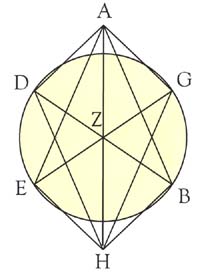Regiomontanus and Mathematical Techniques
 Diagram reproduced from Regiomontanus' Triangulis Omnimodis.
Diagram reproduced from Regiomontanus' Triangulis Omnimodis.
Regiomontanus' major contribution to mathematics was in the field of trigonometry. The tables he calculated of sines and tangents, which were later printed for the use of astronomers, were of great practical value, and contributed to the preference for calculating in the decimal rather than sexagesimal system. His Tabulae primi mobilis provided solutions for spherical triangles, but were largely superseded with the development of logarithmic calculating techniques. More important, perhaps, was the theoretical grounding he elaborated for the subject in his De omnimodis triangulis omnimodis libri quinque. Although unfinished, this work, first printed at Nuremberg in 1533, was of great value to astronomers such as Copernicus and Tycho Brahe.
Books I and II of the text cover planar triangles, dealing first with magnitudes and ratios, then offering geometric solutions for right, isosceles and scalene triangles, before introducing the sine law and instances of its application. Books III to V cover the same ground with respect to the astronomically-all-important field of spherical triangles. While the techniques outlined by Regiomontanus may not have been as original as some of his near-contemporaries and biographers have suggested, the systematic approach of his work and its circulation in print themselves justify awarding him a place of significance in the history of mathematics.